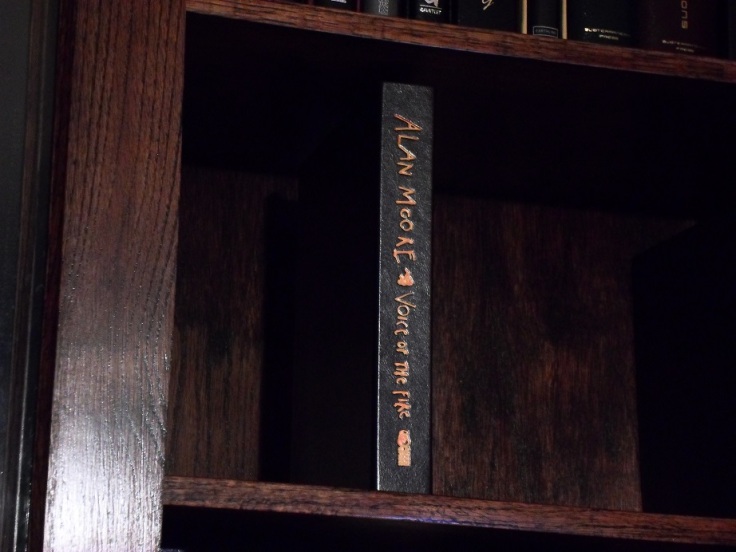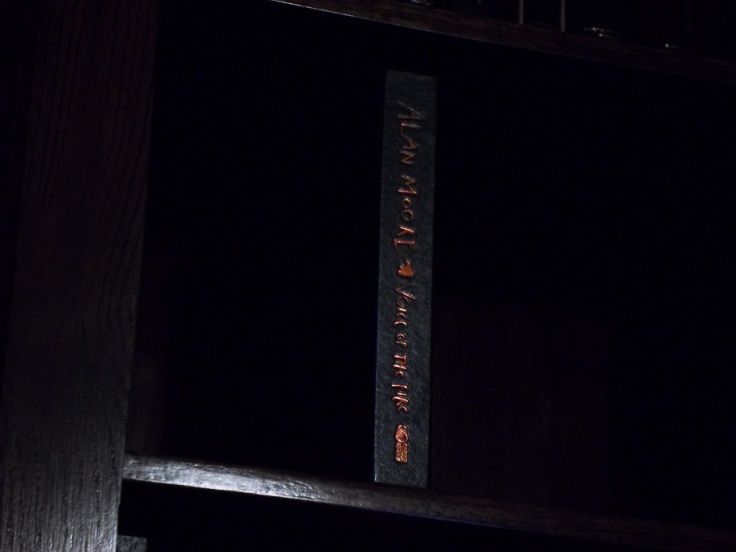by Alan Moore
“Beware, ye that are loath to make commotion! Shudder, ye who would not bring attention on thyself, and see what shyness brought me, with even my gizzard now become a public spectacle. Behold, ye meek: this prong of iron is all the Earth ye shall inherit.”
The following stories take place on the same piece of land, Alan Moore’s home, throughout history. But make no mistake, versions of these events quite easily could have (and did) happen on the site of your dwelling as well, so that makes this book about our homes. The stories build upon each other. When a particular man, creature or event is established in one story, you may expect it to surface again as myth or legend in subsequent stories as the world moves on.
“Hob’s Hog” (4000 BC) – This one’s a ridiculously challenging study of a prehistoric man using his extremely limited vocabulary. It attempts to impart the complexity of his life in regards to the supernatural entity he believes exists and his own injuries as he’s betrayed by other persons in the story. A biting tale that deals with our treacherous natures right out of the gate and opens up the mystery of what you’re about to read. DO NOT SKIM THIS. Doing so might be tempting considering the work that goes into reading this one, but you will miss its greatness and probably miss its echoes throughout the later tales. Embrace the challenge and you’ll be rewarded. It’s an amazing read.
“The Cremation Fields” (2500 BC) – Another excellent story, using a much friendlier vocabulary, this is the tale of an unscrupulous man who converses with and then murders the estranged daughter of a village cunning-man (a witch). He hatches a plan to take her place as the cunning-man’s descendant to inherit his vast wealth as the old man nears death.
“In the Drowings” – (AD 43) A very strong story, this is a tale of a man who, angered with his wife, storms out of the house for a remote hunting trip where he can calm down in peace. When he returns, things are not as he left them, and in his sorrow he adapts to his new situation in a very human way.
“The Head of Diocletian” (AD 290) – This is the tale of a man investigating the forgery of Rome’s currency only to discover the world isn’t as it seems. A masterful story that underlines the fact regardless of which position we view the world, which perspective we’ve adopted, we probably have little idea of what’s really going on. And perhaps that’s a good thing.
“November Saints” (AD 1064) – Finally, a comparatively weak story, where the tomb of a saint is discovered as narrated by a beggar outside the church, but it’s still good. It’s just that the others are even better.
“Limping to Jerusalem” (AD 1100) – The lowest rated of the bunch and the only story to plumb the depths of ‘fair,’ this is the tale of a knight constructing a round church so that the devil may not have a place to hide. This one was more difficult to follow.
“Confessions of a Mask” (AD 1607) – This is the story of a mask, dead at least two years but still conscious, hung in its cage by the side of the road as a warning against transgressions. As the mask laments his lot in life he is joined by another death, this one also conscious as they keep each other company. Hilarious and poignant, here was another highlight.
“Angel Language” (AD 1705) – The story of a lascivious judge visiting a town to pronounce his sentence upon a local thief and the women he seduces on his journey there, this was another highlight.
“Partners in Knitting” (AD 1705) – This one’s a story of two witches being burned while one reminisces about their lives and work together. It handles witchcraft like an enchanted sword, cutting the story to ribbons around the reader while you ingest the falling confetti, and is a major highlight in a book with far more than its share of highlights.
“The Sun Looks Pale Upon the Wall” (AD 1841) – Another of the more challenging stories here, this one is told by a half-mad man and uses no punctuation. It’s difficult to tell what is reality and what is imaginary as we follow the narrative of the man as he is with his second wife, constantly thinking back to his first wife, who may not have entered into matrimony with him except in his own mind.
“I Travel in Suspenders” (AD 1931) – Here’s a tale about a traveling salesman whose penchant for women has him in two separate marriages with girlfriends on the side, and he is always looking for ways into the affections of the next girl. His proclivities get him in all manner of trouble where he uses his verbal skills as a salesman to spin lies and escape discovery. He’s been spinning so long it doesn’t take much for him to get confused as to which statements were made to whom. When his car is found burned in a field with a body inside the hapless salesman has some explaining to do.
“Phipps’ Fire Escape” (AD 1995) – The final story should be left a complete mystery to avoid spoiling anything and maintain the mystique. You’ll see.
As a whole this book is far from your typical read. It’s filled to the brim with occult, mystical reference, has a good amount of mystery and a concentrated style of prose that means it’s nearly impossible to grasp these stories when you’re only half paying attention, watching the kids play in the park. The book demands your full attention, and giving it any less means you’ve either got a T-1000 terminator processor or you’ve missed the story.
Challenging and brilliant, handling the supernatural in our past with a seasoned instructor’s patience while giving us plenty of warnings about paying too much attention to history, The Voice of the Fire is complicated enough to give no illusions about catching everything on the initial read. It’s complexity, however, is a wonderful reason to pull it back off the shelf in the future. There are secrets here to those who would find.
“All that remains in question is whose map we choose, whether we live within the world’s insistent texts or else replace them with a stronger language of our own.”
5- stars













Always happy to hear from book lovers. Please feel free to comment!